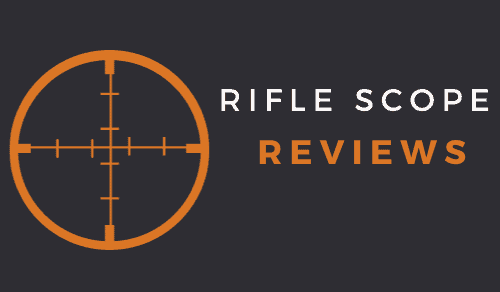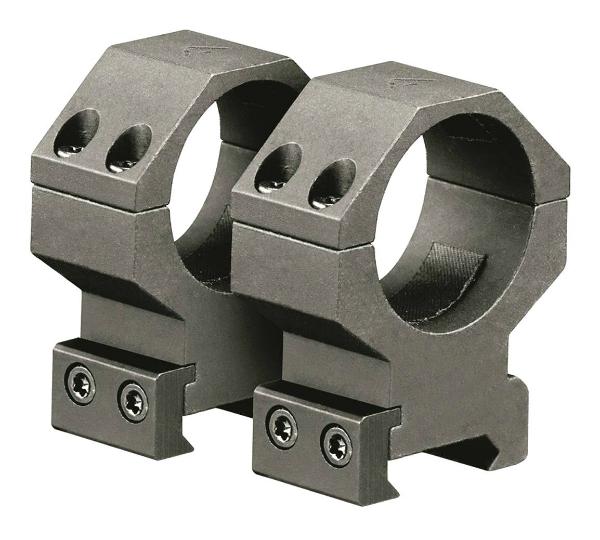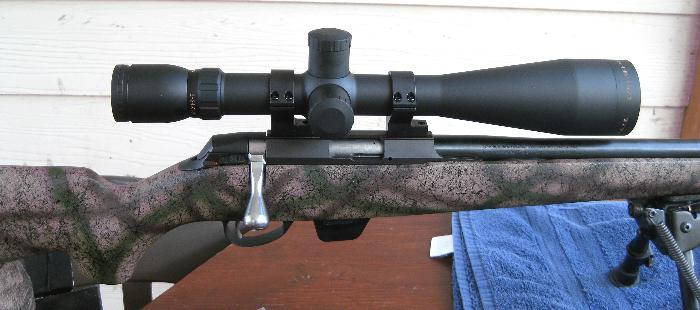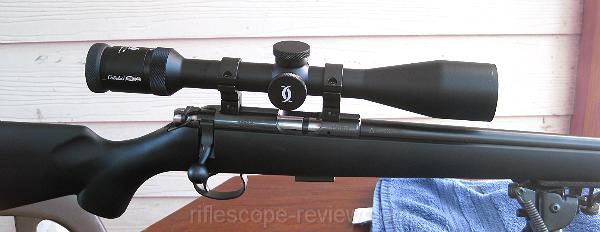As an Amazon Associate I earn from qualifying purchases. Amazon and the Amazon logo are trademarks of Amazon.com, Inc, or its affiliates.
So you’ve bought your new rifle scope, and now need to start the process of actually mounting it to your rifle. Now is the time to start thinking about scope bases and/or scope rings. Bases and rings mean different things, but both are directly related to mounting a scope on a rifle, shotgun, or pistol.
Let’s provide some more context on exactly what the differences are between rings and bases:
Scope rings – “Rings” is kind of a general term used to describe the actual attachments that affix the scope to the firearm. Some ring mounts attach the scope directly to the firearm, while others require a special mount that is, in turn, mounted to the firearm, and then the scope rings attach to the base or base mounts.
Bases – Not every firearm is designed with an integrated ability to mount a scope to it. So, those firearms require a special attachment, commonly called a base, to be mounted to the firearm as a means to connect the scope rings to the firearm.
It sounds much more complicated in writing than it really is, and images will do a far better job of explaining the differences.
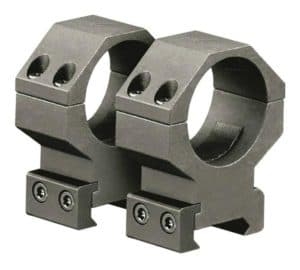 |
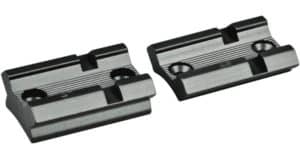 |
| Scope Rings | Scope Bases |
Before we get too deep into a discussion of scope rings, it’s vital to understand the role and importance that rings and bases play in terms of accuracy. The rings (and/or bases) are the only points where the scope attaches to the firearm, and if that mounting or attachment isn’t completely secure, then the scope can move or shift.
That moving or shifting, even the slightest bit) will adversely impact the accuracy as the current zeroing of the firearm is now off its original point of impact.
The analogy I always use is that scope rings and bases are like tires on a Porsche sports car. If you want the Porsche to operate at its full speed and cornering capability, you have to supply it with tires that are made specifically for that purpose. If you buy cheap or non-performance tires for your Porsche, it just won’t perform as well as the tires are the only points where the car touches the road.
Rings and bases are the same way. I’m always confused to see customers come to the scope counter, spend an hour looking at and talking about scopes, choose a $1000 rifle scope, and then buy a $15 set of rings to mount it to a $1000 rifle. Where’s the weak link in this equation? The $15 rings.
I’m not saying you have to buy expensive rings or bases, but, at least buy good ones. You’ll be much happier in the end.
Here are a few more important things to understand about scope rings:
Ring Size
The scope rings have to match the tube diameter of the scope. So a 1-inch scope needs 1-inch scope rings and a 30mm scope needs 30mm rings. Technically, you could mount a 1-inch scope in 30mm rings, but the fit would be terrible.
1 inch and 30mm are the two most popular tube diameters, but there are some other diameters that you may see on the market. Those include a 20mm tube (usually a short-range scope) or a larger 34mm tube that is becoming more popular on long-range scope models.
Scope ring height
Scope rings come in different heights which plays a role in how high the scope rides above the bore. The closer the scope rides to the bore of the firearm means fewer adjustments (holdovers or holdunders) at various differences. I found this out the hard way when I was a teenager and I’ll share that story with you a bit later in this article. Ideally, you want the scope to be mounted as close to the bore of the firearm as possible.
There are a number of very popular scope ring (and bases) manufacturers, and each one offers rings of different heights. But, for the most part, most ring brands offer rings in either a low (also called standard) height or a high height. Some ring manufacturers also refer to low rings as low profile scope rings.
Some of the higher-end scope ring brands offer more in-depth ring heights including an extra-low, low, medium, high, and extra high height.
The lowest setting for scope ring height is the size of the ocular bell. Those bells come in different sizes and are measured in millimeters (mm). The most popular ocular bell sizes are:
- 32mm
- 38mm
- 40mm
- 42mm
- 44mm
- 50mm
The larger the ocular bell size equates to a higher mandatory ring height so the scope doesn’t touch the barrel, and the firearm action can function appropriately. For example, with a bolt action rifle, the scope has to be mounted high enough to allow for the bolt action to work without coming into contact with the scope.
So to put that in more layman’s terms: if I’m mounting a scope with a 40mm ocular to a bolt action rifle, I can probably use low or maybe medium height rings (if bases are involved in the equation). But, if I’m mounting a scope with a 50mm ocular bell, I may have to move up to high rings, or maybe medium-high (depending on the scope ring brand) to accommodate the larger 50mm ocular bell.
Now let’s go back to my story about learning about ring heights when I was younger. When I was in my teens, I always had an interest in lever-action guns, so for my 14th Christmas, my parents bought me a Marlin 39A lever action .22. The rifle can with open sights, and it didn’t take long for me to figure out that I wanted to mount a scope on it to be more accurate.
I took the rifle up to the local gun store and the clerk there sold me on a fixed 4X32mm scope, and also talked me into a scope mount for the Marlin called a “see-thru” mount so I could use either the open sights on the rifle for shorter-range shots or the scope for longer range shots. Well, I was sold so that’s what I bought and that’s what he mounted for me.
I took the rifle out and, with my dad’s help, sighted it in for about 35 yards because 35 yards was kind of my average shooting distance. Well, I was fairly accurate up to 35 yards and took a slew of squirrels with that Marlin during my teenage years.
However, I noticed that I had an accuracy problem with shots at 50 yards or longer in that those shots appeared to hit low of the target, even when I adjusted with some “Kentucky” windage holdover. No matter how much I practiced, I couldn’t get the longer shots to work. At first, I thought it was me, but even my most accurate shooting friends struggled at ranges of 50 yards or more.
Now my next-door neighbor at the time was an older gentleman who was quite the “gun guy” and he had been quite the shooter during his time in the military. I asked him about my longer-range issues, and, after looking at my rifle, said that the issue was the see-thru mount on my rifle. If you’ve ever seen a see-thru mount, it mounts the scope about 3 inches over the barrel so the shooter can still use the factory sights as well.
I had no idea what he meant and couldn’t understand his logic, even when he explained it to me again. Well, being a somewhat polite kid, I thanked him for his time and went back to my house. I think he sensed my lack of understanding so he said: “the next time I go shooting, why don’t you come along and I’ll show you what I mean”.
He and my dad were friends so I was granted permission to go with him on his next trip to the shooting range. During that trip, he took my Marlin 39A .22 and test fired it a number of times off sandbags. He then showed me that the scope was mounted so high off the barrel that it was causing issues with impact at 50 yards with my 35-yard sight-in difference. He basically drew it out on a piece of paper and seeing it illustrated made sense.
Since I wanted to keep the see-thru mounts, he showed me how to adjust with Kentucky windage to make hits at 50 yards and longer. It took a bit of practice but I was able to make it work.
To further illustrate his point, he let me shoot his Winchester 52 .22 target rifle that had a fixed 10X scope on it. The scope was mounted right on the barrel with a special low mount and I was able to hit targets at 25 yards, 35 yards, and 50 yards, with very little holdover or under adjustments. Although the physics of it escaped me as a teenager, it made more sense after that.
That’s a long story to reinforce the point that you really want the scope mounted as close to the bore of the firearm as possible.
Not all rings and bases look the same
Something to clarify here based on the example pics I included above: rings come in a number of different configurations and may not always be two separate rings. Sometimes, they are one-piece rings, and other times, you may see rings and bases combined into a single unit. The actual design and layout of rings/bases vary greatly across the different ring manufacturers.
And to make things even more confusing, some rifle and shotgun brands built models that have a special proprietary system that requires special rings or mounts that only that rifle or shotgun brand or manufacturer offers. For example, the Ruger 77/22 series of bolt action rifles requires specially made Ruger brand rings and really won’t work with any other aftermarket rings or bases.
In addition, if you have a rifle, shotgun, or AR with a Picatinny rail, you’ll need rings made to fit a Picatinny rail. Several ring manufacturers offer 30mm and 1 inch scope rings for Picatinny rail use. If you’re shopping for AR-based rings, there are also several brands that offer 30mm and 1 tactical scope rings.
Here are a few of the more commonly asked questions I see and hear at the scope counter (in no particular order):
What are the best scope rings?
There really are no best scope rings as best is strictly based on one’s opinion. Honestly, there are way too many variables to consider for anyone to deem a specific set of rings as being the “best”. Those variables include:
- Rifle/shotgun model (As rings and/or bases are very rifle or shotgun specific)
- Scope tube size
- Scope bell size
- Desired mounting height
- Desired eye relief (as some ring set-ups will limit the adjustability which may limit the amount of eye relief)
There are just too many moving parts to name one ring or base as the top dog. Now you can certainly have top brands, and my favorite brand hands down are Talley Rings out of South Carolina. After Talley, I also like BKL rings (but they can be hard to find). I also like Weaver rings and bases, along with Leupold rings and bases.
What about quick detach scope rings?
To be honest, my personal experience with quick detach scope rings has been less than stellar. On paper, the idea of having one scope that you can move between different rifles via quick detach rings and bases is awesome. However, in my experience, the reality is something different.
I’ve yet to see a quick detach ring/bases set-up that works and maintains the rifle zero. There are plenty of quick-detach systems on the market now (Warne makes one of the more popular ones) that make it easy to move a scope from one rifle to another. However, the POI is never exactly the same. Now it might be close, but I’m too anal retentive to be satisfied with just “being close” to on.
I love the concept but haven’t seen anything that works as well as advertised yet.
What scope rings do I need?
I couldn’t even begin to say without having more details. The answer will depend on the rifle model, scope model, how you want it mounted, desired mount height, etc. All those factors have to be taken into account before I could even begin to offer any kind of suggestion.
How tight should scope rings be?
This question actually pertains to the cope mounting process and is asking how much force or how tight should the ring screws be turned during the scope mounting process. The amount of force for this type of question is usually measured in inch/pounds. It’s commonly called the torque weight and refers to using a torque wrench or driver to drive the screws in at a pre-defined in/lbs.
The suggested torque settings will vary depending on the ring/base brand as every brand has different “recommended” torque settings. Those recommendations usually vary between 15-20 in/lbs all the way up to 30 in/lbs (which I think is a little high).
Something else to keep in mind is that the suggested torque settings for mounting the rings or bases to the rifle will also be different from the manufacturers’ suggested torque settings for mounting the scope in the rings.
For example, here are the suggested torque settings for Talley rings from the Talley rings website:
- Lightweight rings: 17-20 in/lb on ring screws.
- Steel fixed rings: 30 in/lb bottom screw, 20 in/lb top screw.
- Steel screw lock detachable and quick release ring: 6-48 bottom screws 30 in/lb, 10-32 screw 35 in/lb, top screws 20 in/lb.
- Picatinny rings: 20 in/lb on ring, 65 in/lb on locking nut.
- Base screw torque can depend on the receiver. Please check with the rifle manufacturer or call us for the recommended torque.
What are tactical scope rings or a tactical scope mount? Are they different from regular rings?
Typically speaking, tactical scope rings or tactical scope mounts are generally used to mount an optic on an AR-based firearm platform. For the most part, this means either an AR-15 or AR-10 type of semi-automatic rifle.
Because most tactical-style mounts are geared towards the AR platform, they are typically made to work with a picatinny-based rail system.
As you can see, there are different torque settings suggested for the different rings based on the ring material and ring styles.
I’d suggest reading all the literature that comes with the bases and rings and then using a torque wrench to set the screws to the suggested torque values. I can’t tell you how many times customers have come to the scope desk complaining that their rifle won’t hold zero, and the issue was the rings not being tightened to the necessary torque specs. It’s worth investing in a torque wrench as they aren’t really expensive.
I’ve been working in the firearms and sporting optics industry for over 20 years, with a personal and professional interest in all things related to rifle scopes, Through a combination of work experience, formal training, and personal experiences, I have extensive experience mounting, testing, and evaluating different rifle scope models across most major optical brands.
